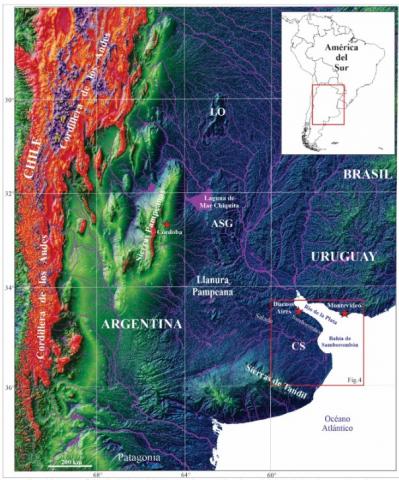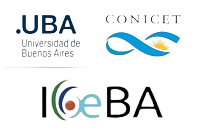Eduardo Antonio ROSSELLO, Gerardo VEROSLAVSKY2
2 024
Revista de Geociencias, 03/2024
A Baía de Samborombón localizase no litoral bonaranse, no estuário do Rio da Prata. Apresenta característica morfologia semicircular, com aproximadamente 100 km de extensão, entre Punta Piedras (ao Norte) e o Cabo San Antonio (ao Sul). A coincidenciacom a subjacente Bacia de Salado permite traçar relações tempo-espaciais entre sua morfologia e sua história tectonossedimentar. A exumação andina aporta sedimentos até a margem passiva atlântica. No Plioceno houve uma diminuição na taxa de sedimentação devido à colmatação dos ambientes da Planície Pampeana. A interposição do leque aluvial de Córdoba contra o Alto San Guillermo gerou a Laguna Mar Chiquita e modificações na drenagem. Assim, com taxa de subsidencia de ~0,09 mm/ano da Formação Las Chilcas (Maastrichtiano-Paleoceno), reduz-se a ~0,005 mm/ano da Formação Puelches (Plioceno-Pleistoceno), com média de 0,042 mm/ano para as formações eocênicas Los Cardos e Olivos. O balanço progressivo negativo entre a taxa de sedimentação vs. subsidenciadetermina que a Bacia de Salado seja um depocentro faminto (altamente receptor) que propiciou o avanço do mar terra adentro na Baía de Samborombón. Dessa forma, apresentam-se cordões conchíferos, áreas úmidas, baixios e pântanos onde o desenvolvimento de altos a partir do Sul favoreceram para a progressiva continentalização.
Samborombón Bay is located on the Bonaerense coast, in the estuary of the River Plate. It has a characteristic semicircular morphology, approximately 100 km long, between Punta Piedras (to the north) and Cape San Antonio (to the south). The coincidence with the underlying Salado Basin makes it possible to trace time-space relationships between its morphology and its tectonosedimentary history. Andean exhumation brought sediments to the Atlantic passive margin. In the Pliocene there was a decrease in the rate of sedimentation due to the filling in of the environments of the Pampean Plain. The interposition of the Córdoba alluvial fan against the San Guillermo High generated the Mar Chiquita Lagoon and changes in drainage. Thus, the Las Chilcas Formation (Maastrichtian-Paleocene) sedimentation rate of ~0.09 mm/year is reduced to ~0.005 mm/year of the Puelches Formation (Pliocene-Pleistocene), with an average of 0.042 mm/year for the Eocene Los Cardos and Olivos formations. The progressive negative balance between the rate of sedimentation vs. subsidence determines that the Salado Basin is a hungry (highly receptive) depocenter that has led to the advance of the sea inland into Samborombón Bay. In this way, there are conch strands, wetlands, shallows and marshes where the development of highlands from the south favored progressive continentalization.

